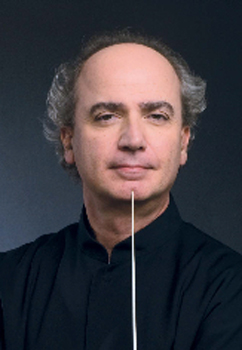Miami Symphony offers “the three B’s” in worthy season finale

Eduardo Marturet led the Miami Symphony in its season finale Friday night at the Arsht Center.
The Miami Symphony Orchestra’s final concert of the season saluted Bach, Beethoven and Brahms, the three great B’s of classical music, to the delight of a large audience Friday night at the Arsht Center.
Leopold Stokowski’s arrangement of Bach’s Passacaglia and Fugue in C minor opened the program and displayed the ensemble at its best. From the stately initial bars sounded by the cellos and basses, Eduardo Marturet shaped the music with spaciousness and grandeur to match Stokowski’s cinematic orchestration. Crisp string articulation and resounding brass approximated the sonorities of a pipe organ, the sound rich and voluminous.
The Triple Concerto in C Major is not Beethoven’s most inspired work. Combining the chamber music trio of violin, cello and piano with orchestra, the score can seem long winded, particularly during the Rondo alla Polacca finale in which a single theme is subjected to endless repetitions.
Still, there is much graceful instrumental writing and the three soloists encompassed Beethoven’s felicitous melodies and strokes of bravura ably. Cellist Katinka Kleijn, a member of the Chicago Symphony Orchestra, was the clear star, producing gorgeous tone and sailing through Beethoven’s virtuosic flights with incisive verve. A superb collaborative artist, Kleijn blended splendidly with her colleagues and brought majesty to the solo in the Andante, phrasing the melodic line eloquently.
After some initial intonation problems, violinist Anne Chicheportiche’s tonal sweetness, alert dynamic detailing and commanding musicality impressively dominated the performance. Ever a reliable player, Ciro Fodere’s digital dexterity and fluent pianism articulated the important keyboard line with aplomb. A reduced ensemble handled Beethoven’s orchestral writing capably but Marturet’s conducting fitfully lacked the spirit and dynamism of his soloists.
After repeated curtain calls, Chicheportiche, Kleijn and Fodere played a high-energy medley of tango melodies by Astor Piazzolla. The uninhibited raw energy and wistful melancholy of this Argentinian music displayed the players’ virtuosity and tonal sheen.
Brahms’ Symphony No. 3 in F Major is the most reflective and autumnal of that master’s symphonic essays. Marturet has recorded all four of Brahms’ symphonies (with the Berlin Symphony) and understands the unique blend of urgency and darkness that permeates these scores. He set a robust, thrusting tempo in the opening Allegro con brio. While the dark, finely gauged sound of the clarinets was impressive, the violin sonority was sometimes thin.
Marturet’s straightforward, unsentimental reading of the Andante exuded lyricism without angst. The haunting melody of the Poco Allegretto was nicely shaped but the performance was marred by repeated lapses in the winds, the players not always in sync with the conductor. In the concluding Allegro, Marturet’s taut approach and clipped phrasing at times diluted the music of breadth yet the coda was appropriately noble and measured.
Following a standing ovation from the highly supportive audience, Marturet led “Nimrod” from Elgar’s Enigma Variations as an encore. Smooth, silky string tone propelled the long limbed melodic line, played with unaffected simplicity as a soft, lovely season finale.
Posted in Performances
Leave a Comment
Sat May 12, 2012
at 1:29 pm
No Comments